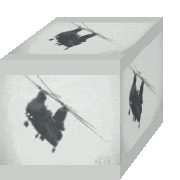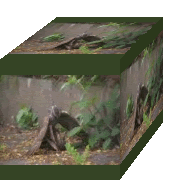 The map of 1610 shows Canwell, or Canwall as it was then known as a small settlement but there is no priory or church. It appears that by 1525 it was deserted and ownership reverted to the King. A survey in 1526 described "The Lady Chapel on the north side of the Chancel was ruinous, all but one side of the cloister has fallen down." In 1530 the bells were sold off for £13 6s 8d.
The map of 1610 shows Canwell, or Canwall as it was then known as a small settlement but there is no priory or church. It appears that by 1525 it was deserted and ownership reverted to the King. A survey in 1526 described "The Lady Chapel on the north side of the Chancel was ruinous, all but one side of the cloister has fallen down." In 1530 the bells were sold off for £13 6s 8d. This early Ordnance Survey map from 1834 shows the hall in existence but the stable block has gone. The fashion was for great gardens and it seems the proud site of the priory didn't fit in with the plans.
This early Ordnance Survey map from 1834 shows the hall in existence but the stable block has gone. The fashion was for great gardens and it seems the proud site of the priory didn't fit in with the plans. A 1960s map marks the site, but there is little to see on the ground. Resident monks would, over time be promoted to Prior and when it came to retirement were well looked after. When Prior John Molton retired in 1400 it was arranged "That he was to have lodgings in the part of the priory lately built in by Ralph Bassett and to receive good food at the priors table and an annual allowance of 33 shillings and 4 pence in silver pennies for dress and other necessaries." In other papers some of these lodgings were described as being "separate and removed from the main party of buildings" to the south. On the map, to the south is a curious patch of woodland now encircled by a farm track.
A 1960s map marks the site, but there is little to see on the ground. Resident monks would, over time be promoted to Prior and when it came to retirement were well looked after. When Prior John Molton retired in 1400 it was arranged "That he was to have lodgings in the part of the priory lately built in by Ralph Bassett and to receive good food at the priors table and an annual allowance of 33 shillings and 4 pence in silver pennies for dress and other necessaries." In other papers some of these lodgings were described as being "separate and removed from the main party of buildings" to the south. On the map, to the south is a curious patch of woodland now encircled by a farm track.I decided to see if I could find any remains of the missing priory buildings....
 The priory was founded in 1140 by Geva, illegitimate daughter of Hugh 1, Earl of Chester. It was a time when people would pay for monks to pray for their souls, assuring a place in heaven. A spring was mentioned to be nearby, later named St. Modwens well. This was my clue as to locating any ruins. I soon found a small stream and tracked it up to a spring line in the slope beneath the wood. Once amongst the trees I discovered a man made gully which deepened to a gorge some 30 foot deep.
The priory was founded in 1140 by Geva, illegitimate daughter of Hugh 1, Earl of Chester. It was a time when people would pay for monks to pray for their souls, assuring a place in heaven. A spring was mentioned to be nearby, later named St. Modwens well. This was my clue as to locating any ruins. I soon found a small stream and tracked it up to a spring line in the slope beneath the wood. Once amongst the trees I discovered a man made gully which deepened to a gorge some 30 foot deep. I knew I was on the right track as all around were old Yew trees. These were traditionally planted in religious places, a throwback to Pagan times when they were believed to ward away evil.
I knew I was on the right track as all around were old Yew trees. These were traditionally planted in religious places, a throwback to Pagan times when they were believed to ward away evil. Soon I came across old dressed stone, local sandstone. There were some good sized pieces and lots of it strewn everywhere.
Soon I came across old dressed stone, local sandstone. There were some good sized pieces and lots of it strewn everywhere.Then, up ahead in the distance at the far end of the ever deepening gorge, I saw it.....
 It looked like a tunnel, but as I got closer I realised it was the remains of an old gate entrance.
It looked like a tunnel, but as I got closer I realised it was the remains of an old gate entrance. It was made of old (you can tell by the narrow section) brick. The mortar was pale and crumbly indicating an early construction.
It was made of old (you can tell by the narrow section) brick. The mortar was pale and crumbly indicating an early construction. Inside you could see the intricacy of the brickwork. There were two small rooms in series with little alcoves at each side.
Inside you could see the intricacy of the brickwork. There were two small rooms in series with little alcoves at each side. The doors from each end had long since gone, the cutouts in the wall indicated their position. It looked as if this archway had once been topped with a large stone structure but it had all collapsed. The gateway led to a curved trackway avenued with Yew, this led to a huge hollow where I suppose the lodgings had been. As I stood there in the failing light I wondered as to what goings on there had been. The monks and priors that had once lived here weren't always what you would expect. In 1272 a monk, William de Sutton (a local), killed a man, fled and was outlawed. The priory was fined 1 Mark for letting him escape. In 1377 there were 3 monks and 1 prior but by 1456 there was a crisis because there were no monks left. When a prior retired he would get a good pension and a resident monk would take over his position. It was quickly realised by the monks that this way they could all retire and live happily ever after. This scam was eventually addressed when it was found that one Prior didn't even live in Canwell and was actually in jail elsewhere!
The doors from each end had long since gone, the cutouts in the wall indicated their position. It looked as if this archway had once been topped with a large stone structure but it had all collapsed. The gateway led to a curved trackway avenued with Yew, this led to a huge hollow where I suppose the lodgings had been. As I stood there in the failing light I wondered as to what goings on there had been. The monks and priors that had once lived here weren't always what you would expect. In 1272 a monk, William de Sutton (a local), killed a man, fled and was outlawed. The priory was fined 1 Mark for letting him escape. In 1377 there were 3 monks and 1 prior but by 1456 there was a crisis because there were no monks left. When a prior retired he would get a good pension and a resident monk would take over his position. It was quickly realised by the monks that this way they could all retire and live happily ever after. This scam was eventually addressed when it was found that one Prior didn't even live in Canwell and was actually in jail elsewhere!





17 comments:
Fascinating, interesting and WAY COOL! Onya Barkfoot!
wow... we love to do things like that... my hubby does the research much like you do. it is so fun to find things like that. thanks for sharing your experience, photos, and video.
Those are incredible photos. I feel as though I were there!
I found myself actually holding my breath as I went from one picture and video to another. Absolutely fascinating. Lets explore again.
Excellent stuff. Great read.
Pablo.
Very cool pictures. I love going out with my camera on a hunt. Maybe it's because I'm an ignorant American, but what the heck is a priory?
Fascinating post. Bet you can't guess where I'll be visiting in the next few weeks?
That's a superb story.
I love old maps. We've decorated with them in the hallways. Mostly National Geographic Society maps from the 1950s.
Jessica - A Priory was a religious 'house', very often grand and including a church. These priories were endowed with land, mills and property which made there influence quite important within government and royalty which to a degree were in competition. Under the reign of King Henry VIII many monasteries and priories were dissolved due to their connection with Rome and Catholic control. Britain is dotted with the remains of huge castle like buildings deliberately destroyed by Royalty. Many of these religious houses had become extremely rich from both endowment and the new industry of sheep farming/ wool. Under dissolvelution much of the wealth was passed onto the new Church of England and its associated bodies of learning (much of Canwells wealth was used to help set up Oxford University). Much of the land and its direct wealth instantly passed to the King.
All this happened in 1534, well before modern America came into being, so, of course, why should you know what a priory is....My apologies for not explaining more thoroughly in the first instance!
Wow that was very interesting, and what a find.
You told it very well.
That Yew tree looks so interesting...I need one in my backyard to ward off evil. lol
This was so cool... you have the most interesting posts. I can see why you are so adventurous, being where you live makes it very easy. There is so much history there!
Too too cool!
:)
Fairies and elfin are fond of ruined priories, and diplomatic delegations often encamp there en route to each other's kingdoms. I saw one in your video, but would prefer not to point out just where...
That's so interesting.. I love old history! I haven't lived in one place long enough to care much about local history - I've lived here for almost 10 years now, though (wow! I actually had to count..), but I have this idea that not much has been going on here. :P Except, well, some cow bartering or something. Field strifes. That sort of stuff. But maybe I should check out our local library; I know there's a section about local history there.
Great pictures, Barkfoot. :) You really capture the atmosphere well! Thank you for sharing!
I like the b&W ones - it shows the structure better of what you were describing.
I forget but is there a way to tell the age of the yew - on the outside?
There are few places here that have maps and are not ruined. Pretty special find.
Christine - Yew is notoriously difficult to age. It is often clipped and pruned and this complicates things. The girth is usually considered to be 1 metre every 500 years, reaching 4 metres in 2000 years, but from then on they often fall, sprout and hollow out so making it difficult to age. There is one growing in Scotland that is thought to be over 2000 years old and there are reports of them living up to 5000 years!
Sometimes an idea of the age can be estimated by counting the rings in an original side branch.
I used to live in Canwell as a kid and have seen this and more including the old platform footings of Canwell Hall and what I think is the remains of the priory or the stables, the ice house and larder tower, the old sewage works in the first tree plantation. Start going nearer Hall wood (the wood on the map with the track around it)you notice loads of ancient trees, feels yesteryear Took my kids round not so long ago, unfortunately Canwell is now under private land ownership, so difficult to get around, but if you know the short cuts, well land is land for everyone!!!
Post a Comment